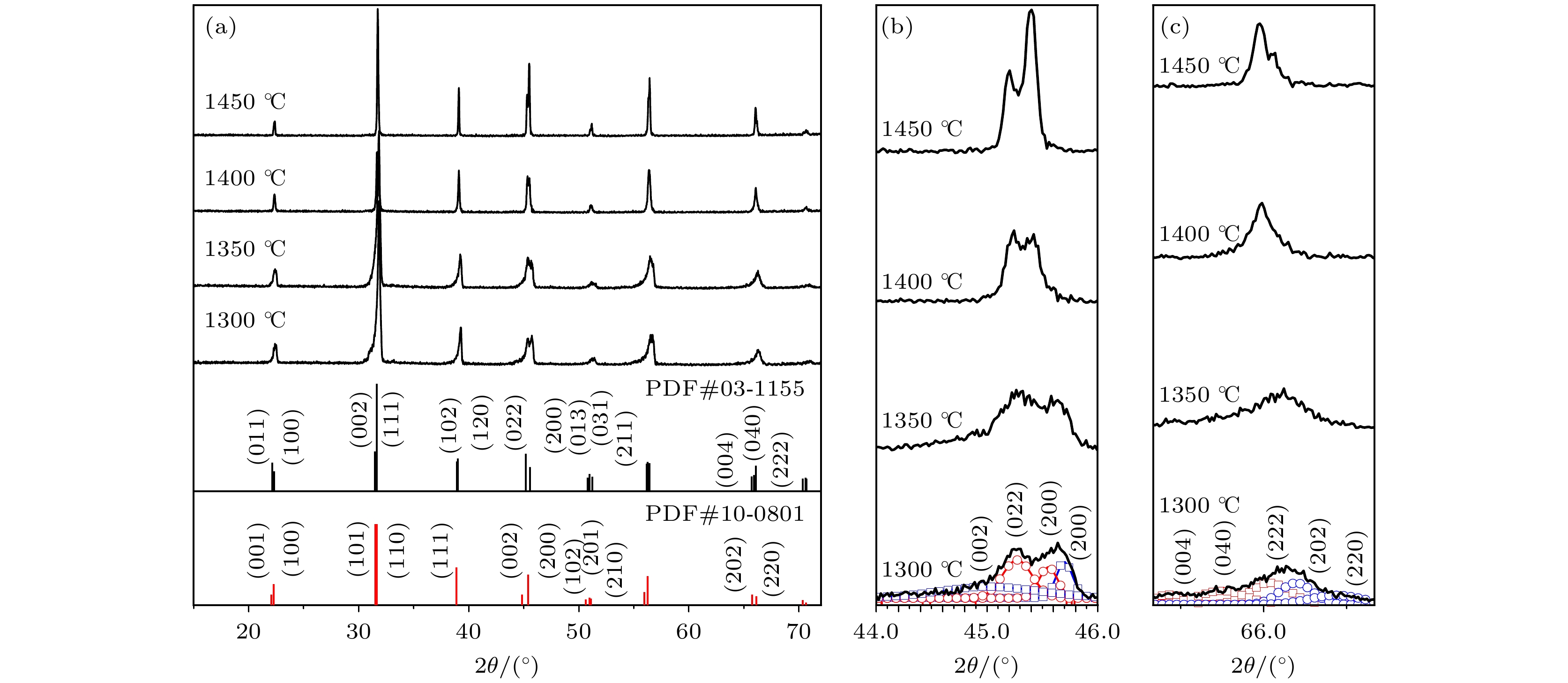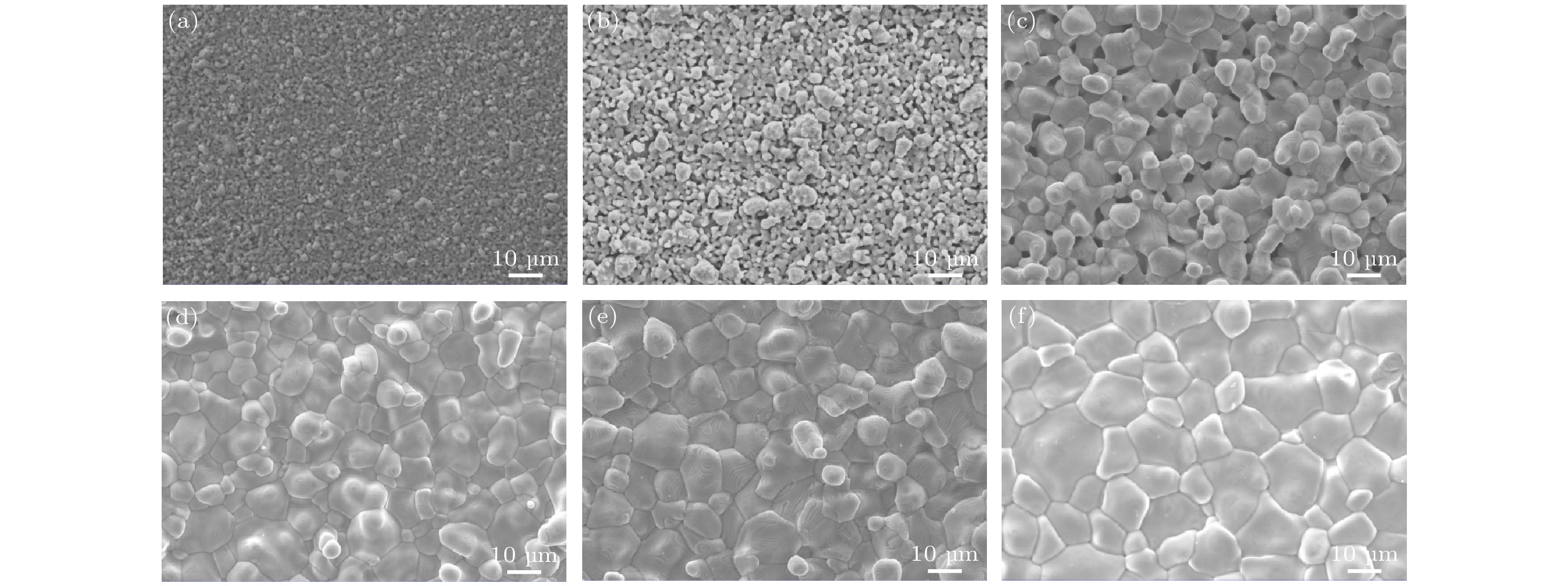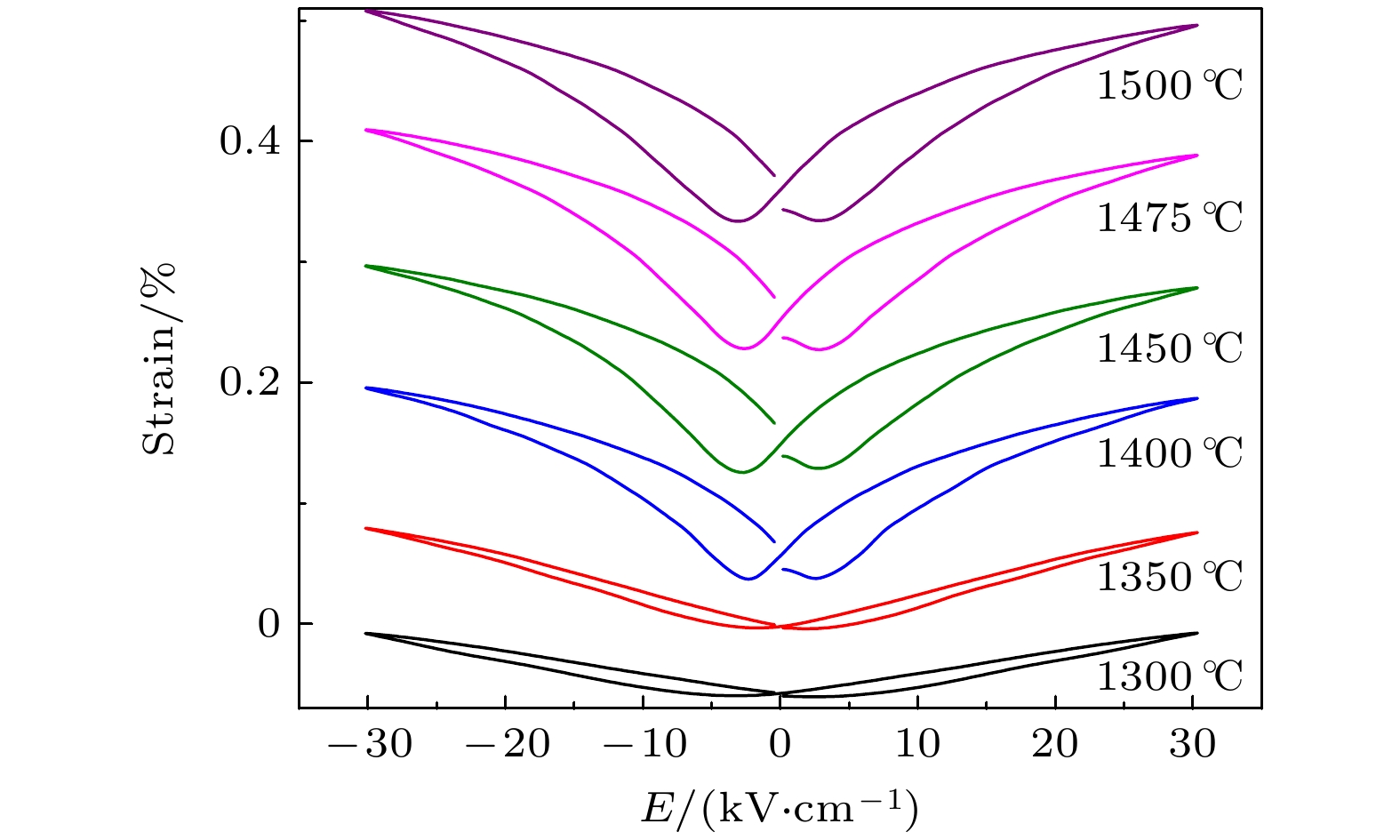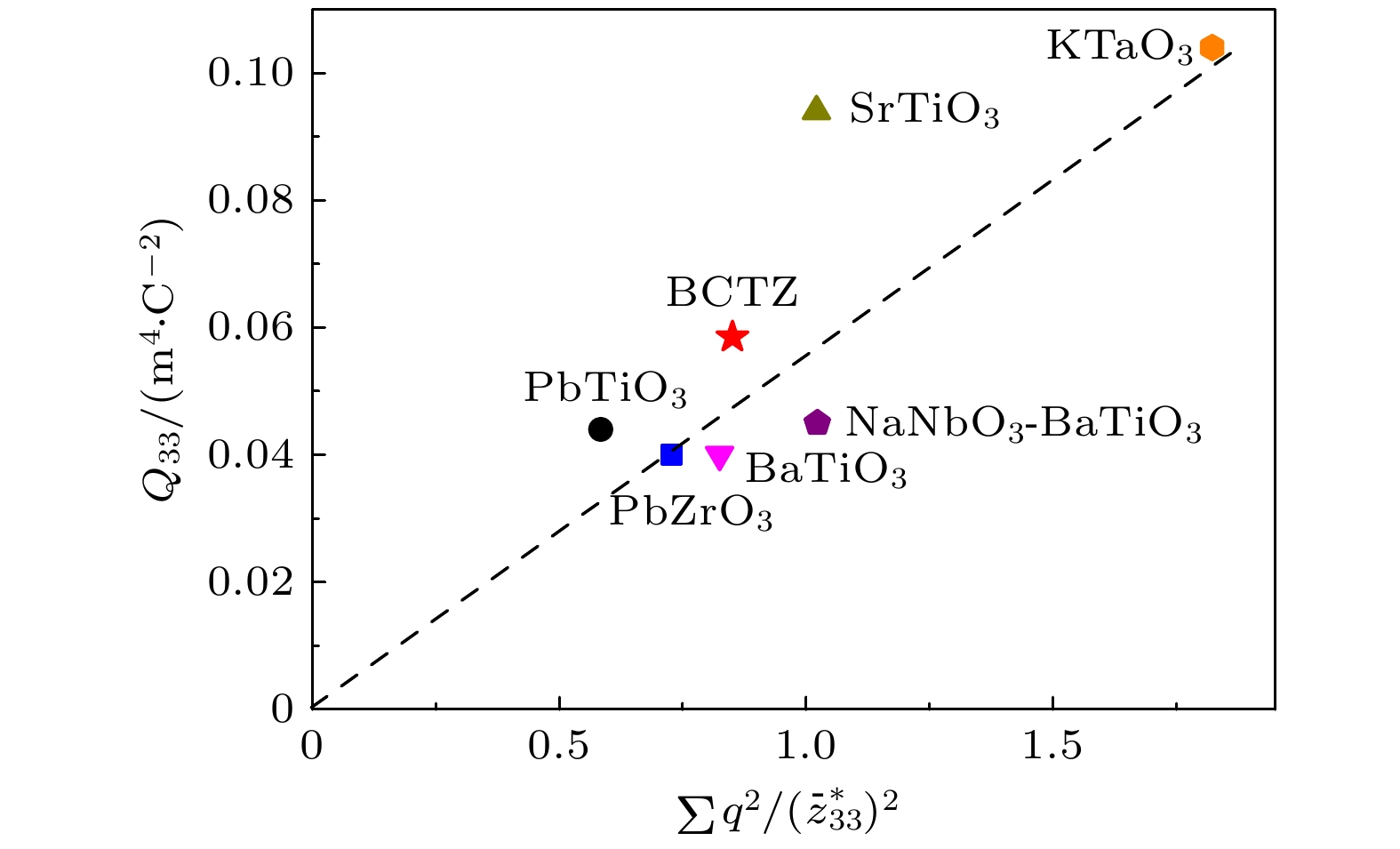-
微位移驱动器在航天、半导体和工业等领域有着重要应用, 现在市场上大部分采用的是铅基压电陶瓷材料. 出于环境保护和法规限制的考虑, 亟需研发具有优良电致伸缩性能的无铅陶瓷材料. 作为一类ABO3型铁电体, (Ba,Ca)(Ti,Zr)O3 (BCTZ) 无铅陶瓷由于具备高压电系数而引发大量关注. 本文借助固相法, 制备了高电致伸缩系数的(Ba0.85Ca0.15)(Ti0.9Zr0.1)O3陶瓷(BCTZ). 研究了烧结温度对BCTZ陶瓷结构和电学性能的影响. 研究结果表明: 在室温附近, BCTZ陶瓷晶相结构形成正交(O)-四方(T)两相共存. 烧结温度促进了BCTZ陶瓷致密性改善和晶粒长大. 当烧结温度为1300 ℃时, BCTZ陶瓷晶粒尺寸在1 μm左右,可获得大电致伸缩系数Q33 (5.84 × 10–2 m4/C2), 大约是传统PZT陶瓷的2倍. 这可能是陶瓷晶粒尺寸所产生的表面效应和A—O化学键所具有的强离子性共同作用的结果. 此外, 室温附近BCTZ陶瓷虽处于正交-四方两相相界, 但陶瓷电致伸缩系数Q33在测量温度为25—100 ℃范围间具有良好的温度稳定性.
-
关键词:
- 无铅陶瓷 /
- (Ba,Ca)(Ti,Zr)O3 /
- 表面效应 /
- 电致伸缩系数
AbstractMicro-displacement actuators have important applications in aerospace, semiconductor, industry and other fields. Now most of the lead-based piezoelectric ceramics are used in the market. In consideration of environmental protection and legal restriction, it is urgent to develop lead-free ceramic materials with excellent electrostrictive properties. As a kind of ABO3-type ferroelectrics, (Ba,Ca)(Ti,Zr)O3 lead-free ceramics have attracted a lot of attention because of their high piezoelectricity. In this work, (Ba0.85Ca0.15)(Ti0.9Zr0.1)O3 (BCTZ) ceramics with high electrostrictive coefficient are prepared by the solid-state method. The effects of sintering temperature on the structures and electrical properties of BCTZ ceramics are studied. The results show that the sintering temperature can help to improve density and grain growth of BCTZ ceramic.There are no impurity phases in the BCTZ ceramic systems, and all samples show ABO3-type perovskite structures. At room temperature, the crystal structure of BCTZ ceramic forms coexistence of orthogonal (O)-tetragonal (T) phase. The dielectric peak of BCTZ ceramic is widened, and the Curie temperature reaches a maximum value of 110 ℃ when Ts = 1300 ℃. With the increase of sintering temperature, the dielectric peak of BCTZ ceramic gradually becomes narrowed, and the Curie temperature of ceramic moves toward low temperature.As the sintering temperature is 1300 ℃, the grain size of BCTZ ceramic is 1 μm, the large electrostrictive coefficient Q33 (5.84 × 10–2 m4/C2) can be obtained, which is about twice that of traditional PZT ceramic. This may be attributed to combination of the surface effect caused by grain size of BCTZ ceramic with the strong ionic nature of A-O chemical bond. In addition, although BCTZ ceramic has an O-T phase boundary near room temperature, the electrostrictive coefficient Q33 of ceramic has good temperature stability in a range of 25–100 ℃. It shows that the crystal phase and temperature have no effect on the electrostrictive coefficient of BCTZ lead-free ceramic. It provides a new idea for designing the high electrostrictive properties of lead-free piezoelectric ceramics with potential applications.-
Keywords:
- lead-free piezoceramics /
- (Ba,Ca)(Ti,Zr)O3 /
- surface effect /
- electrostrictive coefficients
[1] Panda P K 2009 J. Mater. Sci. 44 5049
 Google Scholar
Google Scholar
[2] Takenaka T, Nagata H 2005 J. Eur. Ceram. Soc. 25 2693
 Google Scholar
Google Scholar
[3] Wada S, Nitta M, Kumada N, Tanaka D, Furukawa M, Ohno S, Moriyoshi C, Kuroiwa Y 2008 Jpn. J. Appl. Phys. 47 7678
 Google Scholar
Google Scholar
[4] Huang Y, Zhao C, Wu B, Wu J 2020 ACS Appl. Mater. Interfaces 12 23885
 Google Scholar
Google Scholar
[5] Habib M, Lqbal M J, Lee M H, Kim D, Akram F, Gul M, Zeb A, Rehman I U, Kim M H, Song T K 2022 Mater. Res. Bull. 146 111571
 Google Scholar
Google Scholar
[6] Liu Z G, Tang Z H, Hu S C, Yao D J, Sun F, Chen D Y, Guo X B, Liu Q X, Jiang Y P, Tang X G 2020 J. Mater. Chem. C 8 13405
 Google Scholar
Google Scholar
[7] Jaita P, Jarupoom P 2021 J. Asian Ceram. Societies 9 975
 Google Scholar
Google Scholar
[8] Duraisamy D, Venkatesan G N 2020 Sens. Actuators, A 315 112307
 Google Scholar
Google Scholar
[9] Wu W J, Ma J, Wang N N, Shi C Y, Chen K, Zhu Y L, Chen M, Wu B 2020 J. Alloys Compd. 814 152240
 Google Scholar
Google Scholar
[10] Ni H M, Luo L H, Li W P, Zhu Y J, Luo H S 2011 J. Alloys Compd. 509 3958
 Google Scholar
Google Scholar
[11] Cao W P, Sheng J, Liu Z, Gao C, Wang Z H, Wang J, Chang J, Wang Z, Li W L 2020 Mod. Phys. Lett. B 34 2050100
 Google Scholar
Google Scholar
[12] Varade P, Pandey A H, Gupta S M, Venkataramani N, Kulkarni A R 2020 Appl. Phys. Lett. 117 212901
 Google Scholar
Google Scholar
[13] Chen K, Ma J, Wu J, Wang X Y, Miao F, Huang Y, Shi C Y, Wu W J, Wu B 2020 J. Mater. Sci.-Mater. Electron. 31 12292
 Google Scholar
Google Scholar
[14] Tsai C C, Liao W H, Chu S Y, Hong C S, Yu M C, Wei Z Y, Lin Y Y 2021 Ceram. Int. 47 7207
 Google Scholar
Google Scholar
[15] Wang P, Li Y X, Lu Y Q 2011 J. Eur. Ceram. Soc. 31 2005
 Google Scholar
Google Scholar
[16] Liu W, Ren X 2009 Phys. Rev. Lett. 103 257602
 Google Scholar
Google Scholar
[17] Chen X, Zeng J, Kim D, Zheng L, Lou Q, Hong Park C, Li G 2019 Mater. Chem. Phys. 231 173
 Google Scholar
Google Scholar
[18] Dai Z H, Xie J L, Chen Z B, Zhou S, Liu J J, Liu W G, Xi Z Z, Ren X B 2021 Chem. Eng. J. 410 128341
 Google Scholar
Google Scholar
[19] Li F, Jin L, Guo R 2014 Appl. Phys. Lett. 105 232903
 Google Scholar
Google Scholar
[20] Jin L, Huo R, Guo R, Li F, Wang D, Tian Y, Hu Q, Wei X, He Z, Yan Y, Liu G 2016 ACS Appl. Mater. Interfaces 8 31109
 Google Scholar
Google Scholar
[21] Xiao F, Ma W, Sun Q, Huan Z, Li J, Tang C 2013 J. Mater. Sci. - Mater. Electron. 24 2653
 Google Scholar
Google Scholar
[22] Chen X, Ruan X, Zhao K, He X, Zeng J, Li Y, Zheng L, Park C H, Li G 2015 J. Alloys Compd. 632 103
 Google Scholar
Google Scholar
[23] Okazaki K, Nagata K 1973 J. Am. Ceram. Soc. 56 82
 Google Scholar
Google Scholar
[24] 陈小明, 王明焱, 唐木智明, 李国荣 2021 物理学报 70 197701
 Google Scholar
Google Scholar
Chen X M, Wang M Y, Karaki T, Li G R 2021 Acta Phys. Sin. 70 197701
 Google Scholar
Google Scholar
[25] Yu Z, Ang C, Guo R, Bhalla A S 2007 Mater. Lett. 61 326
 Google Scholar
Google Scholar
[26] Yu Z, Ang C, Guo R, Bhalla A S 2002 J. Appl. Phys. 92 2655
 Google Scholar
Google Scholar
[27] Sciau P, Calvarin G, Ravez J 1999 Solid State Commun. 113 77
 Google Scholar
Google Scholar
[28] Tang X G, Wang J, Wang X X, Chan H L W 2004 Solid State Commun. 131 163
 Google Scholar
Google Scholar
[29] Mastelaro V R, Favarim H R, Mesquita A, Michalowicz A, Moscovici J, Eiras J A 2015 Acta Mater. 84 164
 Google Scholar
Google Scholar
[30] Känzig W 1955 Phys. Rev. 98 549
 Google Scholar
Google Scholar
[31] Cross L E 1996 Mater. Chem. Phys. 43 108
 Google Scholar
Google Scholar
[32] Zhang S T, Kounga A B, Aulbach E, Ehrenberg H, Rödel J 2007 Appl. Phys. Lett. 91 112906
 Google Scholar
Google Scholar
[33] Guo Y, Gu M, Luo H, Liu Y, Withers R L 2011 Phys. Rev. B 83 054118
 Google Scholar
Google Scholar
[34] Yan K, Ren X 2014 J. Phys. D:Appl. Phys. 47 015309
 Google Scholar
Google Scholar
[35] Li F, Jin L, Xu Z, Zhang S 2014 Appl. Phys. Rev. 1 011103
 Google Scholar
Google Scholar
[36] Zuo R Z, Qi H, Fu J, Li J F, Shi M, Xu Y D 2016 Appl. Phys. Lett. 108 232904
 Google Scholar
Google Scholar
[37] Haertling G H 1987 Ferroelectrics 75 25
 Google Scholar
Google Scholar
[38] Weaver P M, Cain M G, Stewart M 2010 Appl. Phys. Lett. 96 142905
 Google Scholar
Google Scholar
[39] Zhang S T, Kounga A B, Jo W, Jamin C, Seifert K, Granzow T, Rödel J, Damjanovic D 2009 Adv. Mater. 21 4716
 Google Scholar
Google Scholar
[40] Bobnar V, Malič B, Holc J, Kosec M, Steinhausen R, Beige H 2005 J. Appl. Phys. 98 024113
 Google Scholar
Google Scholar
[41] Li F, Jin L, Guo R P 2014 Appl. Phys. Lett. 105 232903
[42] Zuo R, Qi H, Fu J, Li J, Shi M, Xu Y 2016 Appl. Phys. Lett. 108 232904
[43] Ghosez P, Gonze X, Lambin P, Michenaud J P 1995 Phys. Rev. B 51 6765
 Google Scholar
Google Scholar
[44] Ghosez P, Michenaud J P, Gonze X 1998 Phys. Rev. B 58 6224
 Google Scholar
Google Scholar
[45] Haertling G H, Land C E 1971 J. Am. Ceram. Soc. 54 1
 Google Scholar
Google Scholar
-
图 4 不同烧结温度下BCTZ陶瓷的介温曲线 (a) Ts = 1300 ℃; (b) Ts = 1350 ℃; (c) Ts = 1400 ℃; (d) Ts = 1450 ℃; (e) Ts = 1475 ℃; (f) Ts = 1500 ℃
Fig. 4. Temperature dependence of dielectric properties for BCTZ ceramics: (a) Ts = 1300 ℃; (b) Ts = 1350 ℃; (c) Ts = 1400 ℃; (d) Ts = 1450 ℃; (e) Ts = 1475 ℃; (f) Ts = 1500 ℃.
图 6 不同烧结温度下BCTZ 陶瓷的S-P曲线: (a) Ts = 1300 ℃; (b) Ts = 1350 ℃; (c) Ts = 1400 ℃; (d) Ts = 1450 ℃; (e) Ts = 1475 ℃; (f) Ts = 1500 ℃
Fig. 6. Strain versus polarization curves for BCTZ ceramics sintered at different temperatures: (a) Ts = 1300 ℃; (b) Ts = 1350 ℃; (c) Ts = 1400 ℃; (d) Ts = 1450 ℃; (e) Ts = 1475 ℃; (f) Ts = 1500 ℃.
表 1 不同烧结温度下BCTZ 陶瓷电致伸缩系数Q33
Table 1. Q33 as a function of sintering temperature for BCTZ ceramics.
Ts/℃ Q33/
(10–2 m4·C–2)R-square εr Average grain size/μm 1300 5.84 0.9772 1621 1 1350 3.51 0.9728 2870 2 1400 4.09 0.98768 2836 6 1450 4.27 0.98677 2781 12 1475 4.34 0.98067 2904 — 1500 4.47 0.98348 2776 14 表 2 不同测量温度下BCTZ 陶瓷电致伸缩系数Q33 (Ts = 1300 ℃; 1475 ℃)
Table 2. Q33 as a function of temperature for BCTZ ceramics (Ts = 1300 ℃; 1475 ℃).
T/℃ Ts = 1300 ℃
Q33/(10–2 m4·C–2)Ts = 1475 ℃
Q33/(10–2 m4·C–2)25 5.84 4.34 50 6.39 4.62 70 6.61 4.78 85 6.76 4.68 100 6.83 4.29 -
[1] Panda P K 2009 J. Mater. Sci. 44 5049
 Google Scholar
Google Scholar
[2] Takenaka T, Nagata H 2005 J. Eur. Ceram. Soc. 25 2693
 Google Scholar
Google Scholar
[3] Wada S, Nitta M, Kumada N, Tanaka D, Furukawa M, Ohno S, Moriyoshi C, Kuroiwa Y 2008 Jpn. J. Appl. Phys. 47 7678
 Google Scholar
Google Scholar
[4] Huang Y, Zhao C, Wu B, Wu J 2020 ACS Appl. Mater. Interfaces 12 23885
 Google Scholar
Google Scholar
[5] Habib M, Lqbal M J, Lee M H, Kim D, Akram F, Gul M, Zeb A, Rehman I U, Kim M H, Song T K 2022 Mater. Res. Bull. 146 111571
 Google Scholar
Google Scholar
[6] Liu Z G, Tang Z H, Hu S C, Yao D J, Sun F, Chen D Y, Guo X B, Liu Q X, Jiang Y P, Tang X G 2020 J. Mater. Chem. C 8 13405
 Google Scholar
Google Scholar
[7] Jaita P, Jarupoom P 2021 J. Asian Ceram. Societies 9 975
 Google Scholar
Google Scholar
[8] Duraisamy D, Venkatesan G N 2020 Sens. Actuators, A 315 112307
 Google Scholar
Google Scholar
[9] Wu W J, Ma J, Wang N N, Shi C Y, Chen K, Zhu Y L, Chen M, Wu B 2020 J. Alloys Compd. 814 152240
 Google Scholar
Google Scholar
[10] Ni H M, Luo L H, Li W P, Zhu Y J, Luo H S 2011 J. Alloys Compd. 509 3958
 Google Scholar
Google Scholar
[11] Cao W P, Sheng J, Liu Z, Gao C, Wang Z H, Wang J, Chang J, Wang Z, Li W L 2020 Mod. Phys. Lett. B 34 2050100
 Google Scholar
Google Scholar
[12] Varade P, Pandey A H, Gupta S M, Venkataramani N, Kulkarni A R 2020 Appl. Phys. Lett. 117 212901
 Google Scholar
Google Scholar
[13] Chen K, Ma J, Wu J, Wang X Y, Miao F, Huang Y, Shi C Y, Wu W J, Wu B 2020 J. Mater. Sci.-Mater. Electron. 31 12292
 Google Scholar
Google Scholar
[14] Tsai C C, Liao W H, Chu S Y, Hong C S, Yu M C, Wei Z Y, Lin Y Y 2021 Ceram. Int. 47 7207
 Google Scholar
Google Scholar
[15] Wang P, Li Y X, Lu Y Q 2011 J. Eur. Ceram. Soc. 31 2005
 Google Scholar
Google Scholar
[16] Liu W, Ren X 2009 Phys. Rev. Lett. 103 257602
 Google Scholar
Google Scholar
[17] Chen X, Zeng J, Kim D, Zheng L, Lou Q, Hong Park C, Li G 2019 Mater. Chem. Phys. 231 173
 Google Scholar
Google Scholar
[18] Dai Z H, Xie J L, Chen Z B, Zhou S, Liu J J, Liu W G, Xi Z Z, Ren X B 2021 Chem. Eng. J. 410 128341
 Google Scholar
Google Scholar
[19] Li F, Jin L, Guo R 2014 Appl. Phys. Lett. 105 232903
 Google Scholar
Google Scholar
[20] Jin L, Huo R, Guo R, Li F, Wang D, Tian Y, Hu Q, Wei X, He Z, Yan Y, Liu G 2016 ACS Appl. Mater. Interfaces 8 31109
 Google Scholar
Google Scholar
[21] Xiao F, Ma W, Sun Q, Huan Z, Li J, Tang C 2013 J. Mater. Sci. - Mater. Electron. 24 2653
 Google Scholar
Google Scholar
[22] Chen X, Ruan X, Zhao K, He X, Zeng J, Li Y, Zheng L, Park C H, Li G 2015 J. Alloys Compd. 632 103
 Google Scholar
Google Scholar
[23] Okazaki K, Nagata K 1973 J. Am. Ceram. Soc. 56 82
 Google Scholar
Google Scholar
[24] 陈小明, 王明焱, 唐木智明, 李国荣 2021 物理学报 70 197701
 Google Scholar
Google Scholar
Chen X M, Wang M Y, Karaki T, Li G R 2021 Acta Phys. Sin. 70 197701
 Google Scholar
Google Scholar
[25] Yu Z, Ang C, Guo R, Bhalla A S 2007 Mater. Lett. 61 326
 Google Scholar
Google Scholar
[26] Yu Z, Ang C, Guo R, Bhalla A S 2002 J. Appl. Phys. 92 2655
 Google Scholar
Google Scholar
[27] Sciau P, Calvarin G, Ravez J 1999 Solid State Commun. 113 77
 Google Scholar
Google Scholar
[28] Tang X G, Wang J, Wang X X, Chan H L W 2004 Solid State Commun. 131 163
 Google Scholar
Google Scholar
[29] Mastelaro V R, Favarim H R, Mesquita A, Michalowicz A, Moscovici J, Eiras J A 2015 Acta Mater. 84 164
 Google Scholar
Google Scholar
[30] Känzig W 1955 Phys. Rev. 98 549
 Google Scholar
Google Scholar
[31] Cross L E 1996 Mater. Chem. Phys. 43 108
 Google Scholar
Google Scholar
[32] Zhang S T, Kounga A B, Aulbach E, Ehrenberg H, Rödel J 2007 Appl. Phys. Lett. 91 112906
 Google Scholar
Google Scholar
[33] Guo Y, Gu M, Luo H, Liu Y, Withers R L 2011 Phys. Rev. B 83 054118
 Google Scholar
Google Scholar
[34] Yan K, Ren X 2014 J. Phys. D:Appl. Phys. 47 015309
 Google Scholar
Google Scholar
[35] Li F, Jin L, Xu Z, Zhang S 2014 Appl. Phys. Rev. 1 011103
 Google Scholar
Google Scholar
[36] Zuo R Z, Qi H, Fu J, Li J F, Shi M, Xu Y D 2016 Appl. Phys. Lett. 108 232904
 Google Scholar
Google Scholar
[37] Haertling G H 1987 Ferroelectrics 75 25
 Google Scholar
Google Scholar
[38] Weaver P M, Cain M G, Stewart M 2010 Appl. Phys. Lett. 96 142905
 Google Scholar
Google Scholar
[39] Zhang S T, Kounga A B, Jo W, Jamin C, Seifert K, Granzow T, Rödel J, Damjanovic D 2009 Adv. Mater. 21 4716
 Google Scholar
Google Scholar
[40] Bobnar V, Malič B, Holc J, Kosec M, Steinhausen R, Beige H 2005 J. Appl. Phys. 98 024113
 Google Scholar
Google Scholar
[41] Li F, Jin L, Guo R P 2014 Appl. Phys. Lett. 105 232903
[42] Zuo R, Qi H, Fu J, Li J, Shi M, Xu Y 2016 Appl. Phys. Lett. 108 232904
[43] Ghosez P, Gonze X, Lambin P, Michenaud J P 1995 Phys. Rev. B 51 6765
 Google Scholar
Google Scholar
[44] Ghosez P, Michenaud J P, Gonze X 1998 Phys. Rev. B 58 6224
 Google Scholar
Google Scholar
[45] Haertling G H, Land C E 1971 J. Am. Ceram. Soc. 54 1
 Google Scholar
Google Scholar
计量
- 文章访问数: 8532
- PDF下载量: 124
- 被引次数: 0














 下载:
下载:










